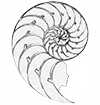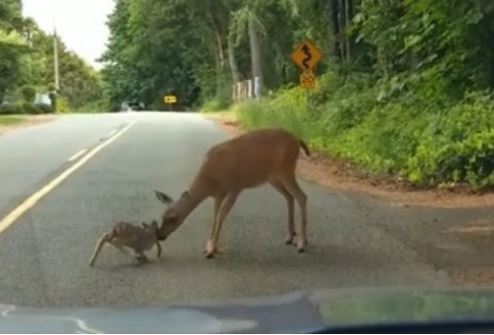Animal videos are at least half the reason I use Facebook. I saw one this week that is such a clear example of how the nervous system moves through stress, I had to share it with you. Watch, then read my play by play. (I recommend watching with the sound off.)
In the video, a fawn, while crossing the road becomes so frightened he/she collapses in the middle of the road. It’s the perfect example of high activation shutting down the system in defense – only the middle of the road is not such a great place for this to happen. We call this the freeze state and it is a response from the dorsal vagus system.
The driver of the vehicle stops the car and turns off the motor. In effect, she’s trying to remove or reduce the source of stress. She is holding space for the fawn – she didn’t get out and “help” him/her by picking up, touching, etc. Instead she gives room for Mama to cautiously approach the baby and signal reassurance and safety.
Almost immediately the fawn gets up and starts to follow Mama. There’s a moment of wobble, where the freeze wants to happen again, but then the fawn’s system regains it’s confidence and he/she trots off with Mama.
We heal in connection.
Our nervous system knows what to do if we give it the time and space it needs. And it does this better if there is someone with us to reassure us that the feelings inside are not going to overwhelm us.
For today, let’s call this the “Fawn Cycle”:
- High activation happens
- Reduce any obvious sources of stress in the environment
- Give the person quiet space and attention
- Add some light reassurance (not too much or it overstimulates)
- Wait for recovery
The “Fawn Cycle” applies to
- Kids (crying, tantrums, bumps and bruises, etc.)
- Anger
- Panic
- Partner under stress
- Stress after a hard day at work
- Fear/anxiety
- Injury/accident (use in tandem with any medical treatment)
And so many more things.
Unfortunately most of us don’t move through big activation as quickly – in large part because we don’t have the practice with regulation that the deer has. And yes, supporting yourself or someone else through the states mentioned above has other considerations, but the core elements are the same.
Suggestions for practice:
- Can you think of a situation where the Fawn Cycle happened in your life? If might be hard to think of something, but see if you can remember a time when you got very upset and it turned out okay. What helped it become okay – did you get information that told you the threat was over? Did someone reassure you? Did you have time to settle or discharge the stress?
- Think of a situation where there was activation and the Fawn Cycle didn’t happen – what part was missing? How might it have felt to have all parts of the Fawn Cycle play out?
Let me know what you discover!
Want more free content? Join the Learning Forum.
The Learning Forum is my free member area that has all the information you need to begin making real progress. Get access to all my videos, my e-newsletter, blogs and course “Strategies for Healing Developmental Trauma.” 




I like the analogy. The video made it clear. Thank you.
Glad it helped, Laura. Hope you’re well!